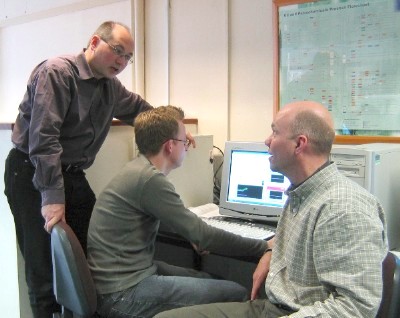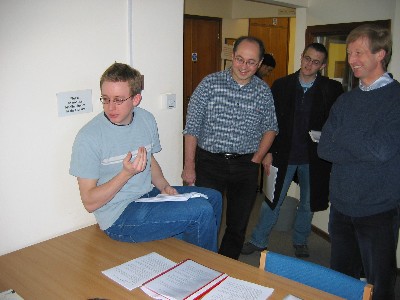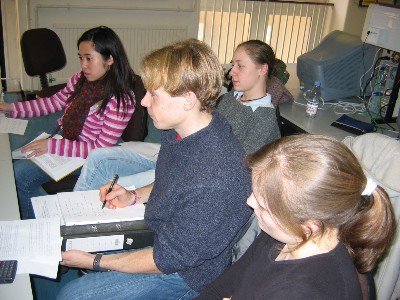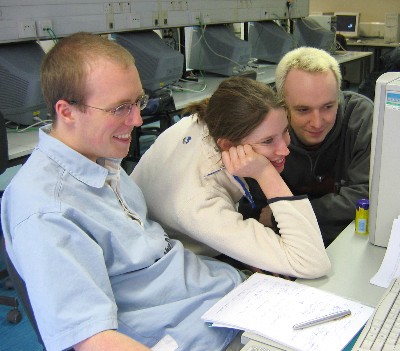Cambridge Students Perform Experiment at MIT over the internet - a CMI funded initiative
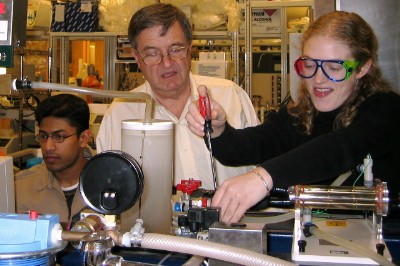
For the first time in 2004, Chemical Engineering Students from the University of Cambridge, UK, performed an experiment located at MIT in Boston on Process Control. The students connected to this experiment, located on the other side of the Atlantic, over the internet. They applied their knowledge of process control, a topic taught in the Chemical Engineering course, to tune a controller for the hot inlet temperature of a heat exchanger. The control and observation of its response was done via a web interface. This experiment replaced a pen and paper exercise of an idealised system for the Process Dynamics and Control Course.
Background
In 1999 MIT and Microsoft announced an alliance to conduct research and create new technologies to improve information technology-enabled teaching models and educational tools for university education. The project was named iCampus and has been running for five years with a budget of $25 million. As a part of this, a number of remote online laboratory experiments, iLabs, have been developed. In one iLab, Prof. Clark Colton of the Department of Chemical Engineering at MIT has set up a heat exchanger for online use in lectures within the "Transport Processes" course. This experiment has been used in the education of MIT chemical engineers since November 2001.
The iLabs allow the students to compare their foundation of solid science to reality in experiments using modern graphical interface technology. The use of remotely controlled processes is widespread in the chemical industry and the students are likely to meet a similar environment later in their professional life. Trying things in a real system motivates the students and satisfies their curiosity of how a system works. Working in a group over the internet also provides the students with up-to-date communication skills.
|
Making use of these advantages and providing further opportunities for practical experimentation in the Chemical Engineering course at CU, Dr Markus Kraft (Cambridge) and Prof. Clark Colton (MIT) posted a proposal to the Cambridge-MIT Institute (CMI) to use the MIT heat exchanger experiment in the Cambridge syllabus and to develop a second experiment, based in Cambridge, for use by students from both Cambridge and MIT. The proposal was successful and in autumn 2003 assignments and experiments were developed and incorporated in the course. The main part of this work has been carried out by Anders Selmer who has working experience in chemical engineering, teaching, and the web authoring. |
The ExerciseChemical Engineering students at Cambridge perform a variety of exercises that are designed to be an intermediate step between idealised, exam-style questions and long-term, large-scale projects. In previous years, the exercise on Process Dynamics and Control has contained a simulation of a flash tank where the numerical solution of the control equations often occupied more of the students' time and thought than the actual control part. In order to allow the students to focus more successfully on the practicalities of control, this exercise was scrapped and a new one incorporating the MIT heat exchanger was developed by Teaching Consortium Teaching Fellow Mike Goodson and Anders Selmer under supervision of Dr John Dennis who is responsible for the exercises. |
|
The new exercise consists of three parts:
- A few preparatory questions on control enabling the students to identify the relevant variables and to calculate control parameters from open loop test data.
- An experimental session with observations of a real system under P, PI and PID-control, followed by fine tuning of the control parameters and testing the response of the system to disturbances.
- Processing of data obtained during the experimental session and follow up questions penetrating deeper into the matter.
The exercise is accompanied by a number of seminars where the students can ask questions and get support on the theoretical parts.
|
The Experiment The MIT heat exchanger iLab was initially designed to demonstrate the principles of heat transfer but in this assignment the focus is on the controller for the hot water inlet temperature and the actual heat exchanger is only treated as a black box. The technical equipment is designed to run over long periods of time with minimal maintenance and, once set up properly by the MIT staff, it could be run for the complete duration of the course with only occasional supervision. After completing the initial part of the exercise the students were given usernames and passwords to be able to log in to the experiment and sign up for a timeslot. Each timeslot could be occupied by up to four students. At their allocated timeslots the students logged in again and performed the experimental part. In addition to the experiment interface a chat client is provided to allow the students to communicate with each other and the tutor during the experiment. |
|
In the first part the students made observations of a system under P, PI and PID control, respectively using parameters obtained by applying the Cohen-Coon method to open loop test data. The next part was to improve these parameters by observing the system's response to disturbances and applying knowledge of the equations governing PID control. Finally they had to record the responses to three different step changes. |
|
|
The OutcomeStudents have so far responded positively to the experiments. 'It was very interesting to use a real piece of quite juicy kit, and to operate it over the web,' says second-year chemical engineering student Cameron Saxby. 'It gave us the chance to put some theories into practice, and it really helped me to understand what process design and control is all about.' 'It's very different', says fellow student Andrew Peevor. 'I hadn't had any experience of using a web interface to manage a technical system. But I liked the fact that when we made adjustments, the graphic displays showed the effects immediately, and we then had to decide how to respond to those changes'. |
Technically the equipment and interface performed without faults during the duration of the course (ten three hour sessions). Feedback was obtained by issuing questionnaires; the students very much appreciated doing a real experiment and being able to see, firsthand, the effects on the system of each of the control parameters. The results of the questionnaire will be published in due course.
The Future
The CMI funded web based teaching project has now been running for three years. The Process Dynamics and Control exercise has been repeated in 2005 and 2006 and a web accessible experiment on reactors has been built in Cambridge together with Siemens Automation Cooperates with Education. This experiment is being used by students from the University of Cambridge and MIT as well as other UK institutions including Imperial College and University of Birmingham.




